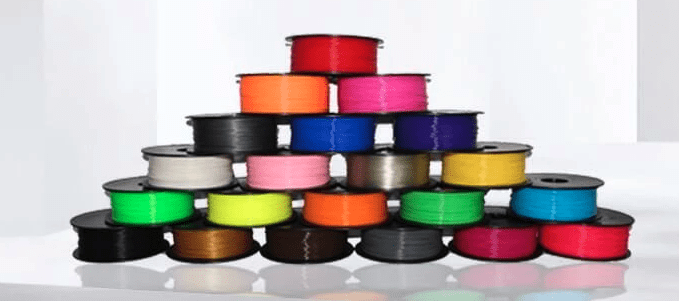
Loading the material may seem to be nothing in front of the complex software processes such as modelling and slicing involved in 3D printing. However, this simple step plays a vital role in determining the quality and precision of your 3D prints. There are certain things that you must keep in mind while feeding your 3d printer with the material. These are:
Check the Spool Size
Before you head to load the spool, check its size. The filament spools come in two sizes- small, that is, 0.22 kg and large, that is, 0.9 kg. Make sure that the size of your spool is in line with the printer. Do not supply a spool that is too big or too small for your printer. It should fit perfectly into your printer. Under any circumstances, do not try to forcefully push a spool into the printer. It can cause problems in the functioning of the device.
Check the Filament Size
The material filament comes in two sizes- 1.75mm and 2.85 mm. Make sure that you have picked the right size of material filament.You can easily get the right kind of filament online for your 3D printer, you just have to check the right size of it.As,your printer will not accept the wrong size of filament. Make sure that you verify the filament size. It should be compatible with your printer. Otherwise, the 3d printing will not be possible.
Make Sure the Material is in Good Condition
If you are loading an old filament into your printer, make sure that it is in good condition. The thermoplastics used in 3d printing can absorb moisture from their surroundings. These filaments will damage your 3d prints, making them appear disoriented and cracked. In order to avoid this, make sure that you store your material filaments in a dry environment. Also, check the condition of your filament before loading it to the printer.
Straighten the Filament
Since the filament is wound over the spool, it will be curved. Now, in order to load the filament successfully to the printer, it needs to be straightened. You can straighten it by bending and creasing the loose end of the material filament. Also, cut the loose end of the filament at a steep angle. This will give a sharp edge to the filament so as to easily enter the extruder head.
Make Sure that the Material Window Faces Forward
During the 3d printing process, the material has to be continuously supplied to the extruder. For this, the spool is rotated in the anticlockwise so as to unwind the material and send it to the extruder. Therefore, it is important that the filament window faces the extruder to facilitate the counterclockwise rotation of the spool.
Make sure to unload the old material
The first and foremost thing that you have to do before starting to load the new material is to get rid of any existing material that might be present in your printer. Even if you are using a new printer, it is important to check for the existing material as most companies send the printer with a pre-loaded spool used while testing the 3d printer.
For this, set the printer to “unload filament.” Follow the commands and extract the filament from the extruder by means of pulling. Finally, wind this filament over the spool and remove this old spool of material from your 3d printer.
Follow the Control Panel Commands
Whenever you are doing anything with your 3d printer, it is important to follow the control panel commands. Whether you are removing the material or supplying a new material, only do so when the printer commands you to. This is due to the fact that in order to extract the material, the extruder has to be heated to a temperature that matches the melting point of the material. It is easier to release the heated up material due to increased viscosity.
On the other hand, if you use force the material in/out of the printer, it may damage the extruder.
Check the Extruder Temperature
Before you start with anything, check the melting point of your material filament. Now set the extruder temperature to this particular point on the control panel. It is necessary that the extruder temperature is exactly the same as the melting point of the material. Otherwise, the filament will not enter the extruder easily. It will require a lot of force to push it into the extruder. It will result in getting bad prints and sticking the filament on hotend. This can even damage the hotend of your printer, permanently.
Pause the Printing Process
If you are in the middle of the printing process and need to change the material, you must first pause the printing process. If you try to forcefully change the spool in between printing, it will not only lead to poor prints but will also damage your printer.
You can pause the process by simply opening to the “print” menu and selecting the “change filament” option. It will pause the process. Now change the material spool. Take as much time as you need. Once done, select the “resume” option. The printing process will begin right where you left. Your 3d prints are saved from getting damaged.
Purge the Nozzle
When you remove a spool of filament from your material cartridge, it does not get completely removed from your printer. There may be some traces inside the extruder nozzle. It is necessary that these fragments are removed from the nozzle before you start printing with the new material. In order to do this, you can use the “move axis” command. This will start the printer. Continue with this process until the new material starts oozing out of the nozzle. This means that the old material has been completely removed from the printer.
